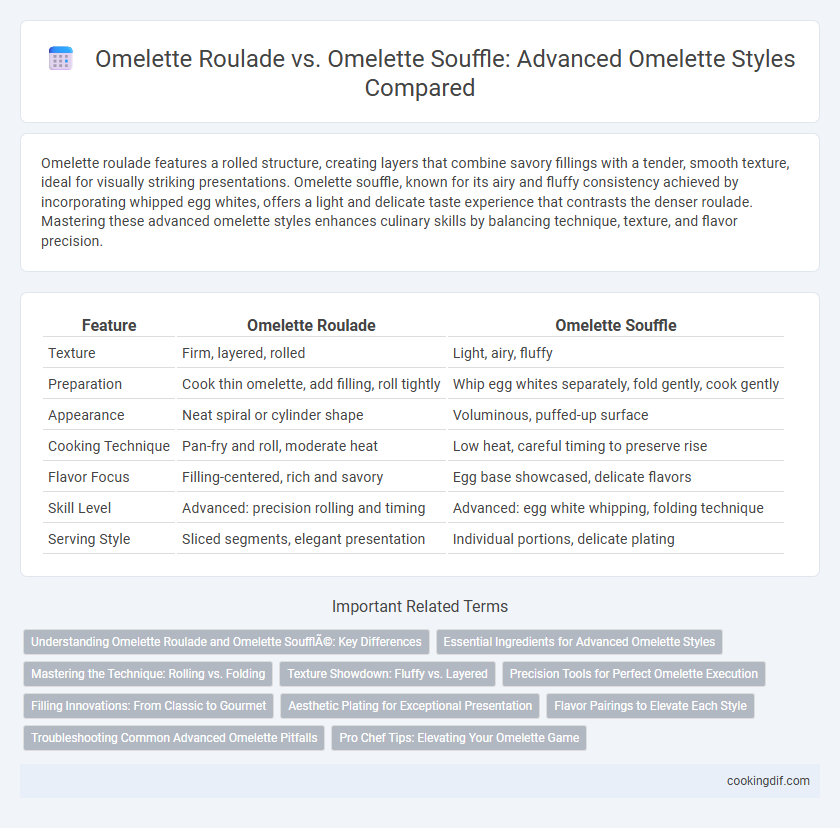Omelette roulade features a rolled structure, creating layers that combine savory fillings with a tender, smooth texture, ideal for visually striking presentations. Omelette souffle, known for its airy and fluffy consistency achieved by incorporating whipped egg whites, offers a light and delicate taste experience that contrasts the denser roulade. Mastering these advanced omelette styles enhances culinary skills by balancing technique, texture, and flavor precision.
Table of Comparison
| Feature | Omelette Roulade | Omelette Souffle |
|---|---|---|
| Texture | Firm, layered, rolled | Light, airy, fluffy |
| Preparation | Cook thin omelette, add filling, roll tightly | Whip egg whites separately, fold gently, cook gently |
| Appearance | Neat spiral or cylinder shape | Voluminous, puffed-up surface |
| Cooking Technique | Pan-fry and roll, moderate heat | Low heat, careful timing to preserve rise |
| Flavor Focus | Filling-centered, rich and savory | Egg base showcased, delicate flavors |
| Skill Level | Advanced: precision rolling and timing | Advanced: egg white whipping, folding technique |
| Serving Style | Sliced segments, elegant presentation | Individual portions, delicate plating |
Understanding Omelette Roulade and Omelette Soufflé: Key Differences
Omelette roulade features thin layers of egg rolled with fillings, offering a smooth texture and visually appealing spirals, while omelette souffle is characterized by its airy, fluffy structure achieved by folding beaten egg whites into yolks. The roulade emphasizes delicate rolling technique and controlled cooking to maintain pliability without cracking, whereas the souffle requires precise timing and gentle folding to ensure maximum volume and a light, tender bite. Both styles highlight advanced culinary skills but differ fundamentally in texture, preparation methods, and presentation appeal.
Essential Ingredients for Advanced Omelette Styles
Omelette roulade requires essential ingredients like eggs, butter, cream, and finely chopped herbs to achieve its tender, pliable texture ideal for rolling. Omelette souffle demands whipped egg whites folded gently into the yolk mixture, along with milk or cream and seasoning, to create a light, airy structure with a delicate rise. Mastery of these ingredient balances defines the advanced techniques of texture and flavor in both omelette styles.
Mastering the Technique: Rolling vs. Folding
Mastering the technique of creating an omelette roulade involves precise rolling to achieve a smooth, cylindrical shape without cracking, requiring controlled heat and timing to maintain pliability. In contrast, an omelette souffle demands delicate folding to preserve its airy texture and volume, relying on the careful incorporation of beaten egg whites and gentle heat application. The roulade technique emphasizes structure and uniformity, while the souffle technique focuses on lightness and a tender, fluffy consistency.
Texture Showdown: Fluffy vs. Layered
Omelette roulade presents a layered texture with thin, rolled folds that offer a delicate chewiness and intricate mouthfeel. Omelette souffle, distinguished by its airy, whipped egg base, delivers a cloud-like fluffiness that melts effortlessly on the palate. This texture showdown highlights the roulade's structured layers versus the souffle's light, voluminous softness, catering to advanced culinary techniques and refined taste preferences.
Precision Tools for Perfect Omelette Execution
Omelette roulade and omelette souffle require precision tools such as non-stick pans with controlled heat distribution and silicone spatulas to achieve flawless textures. Accurate temperature control and timed folding techniques are essential for the roulade's tight spiral and the souffle's airy rise. Advanced styles benefit from digital thermometers and adjustable induction cooktops to maintain consistent cooking environments for perfect execution.
Filling Innovations: From Classic to Gourmet
Omelette roulade offers a sophisticated technique for layering fillings, allowing chefs to explore diverse textures and flavors by rolling ingredients such as smoked salmon, cream cheese, or sauteed mushrooms into thin, tender egg sheets. In contrast, omelette souffle emphasizes airy, delicate folds, incorporating whipped egg whites to create a light structure that pairs well with refined fillings like goat cheese, truffle, or fresh herbs. Both styles push culinary boundaries, transforming traditional omelettes into gourmet dishes with innovative, artistically balanced fillings that highlight advanced kitchen skills.
Aesthetic Plating for Exceptional Presentation
Omelette roulade offers a sleek, spiral form that enhances visual appeal, making it ideal for refined plating with layered fillings displayed elegantly. Omelette souffle, characterized by its airy, puffed texture and golden crust, provides height and volume, creating a dramatic centerpiece in gourmet plating. Both styles lend themselves to advanced aesthetic presentation techniques, emphasizing texture contrast and vibrant garnishes to captivate the diner's eye.
Flavor Pairings to Elevate Each Style
Omelette roulade offers a rich, layered texture that pairs exceptionally well with robust ingredients like smoked salmon, cream cheese, and fresh dill to enhance its savory complexity. Omelette souffle, characterized by its airy and delicate structure, benefits from light, aromatic additions such as chives, Gruyere cheese, and a touch of nutmeg to elevate its subtle flavors. Strategic flavor pairings tailored to each style maximize the unique textures and create a more refined culinary experience.
Troubleshooting Common Advanced Omelette Pitfalls
Achieving the perfect omelette roulade requires precise temperature control to prevent tearing and uneven cook, while maintaining a delicate fold. Omelette souffle demands careful timing and gentle folding to avoid collapse and ensure the airy texture characteristic of this style. Common pitfalls include overcooking, which results in dryness, and under-whipping eggs, leading to a dense, flat outcome rather than the expected lightness and volume.
Pro Chef Tips: Elevating Your Omelette Game
Experts suggest using precise temperature control when making an omelette roulade to achieve a smooth, pliable texture ideal for rolling without cracking. In contrast, mastering an omelette souffle requires delicate egg-whipping techniques to incorporate maximum air, resulting in a light, fluffy interior with a golden, slightly crisp exterior. Using high-quality, fresh eggs and immediate plating enhances flavor and presentation, critical for advanced omelette styles.
Omelette roulade vs omelette soufflé for advanced styles Infographic

 cookingdif.com
cookingdif.com